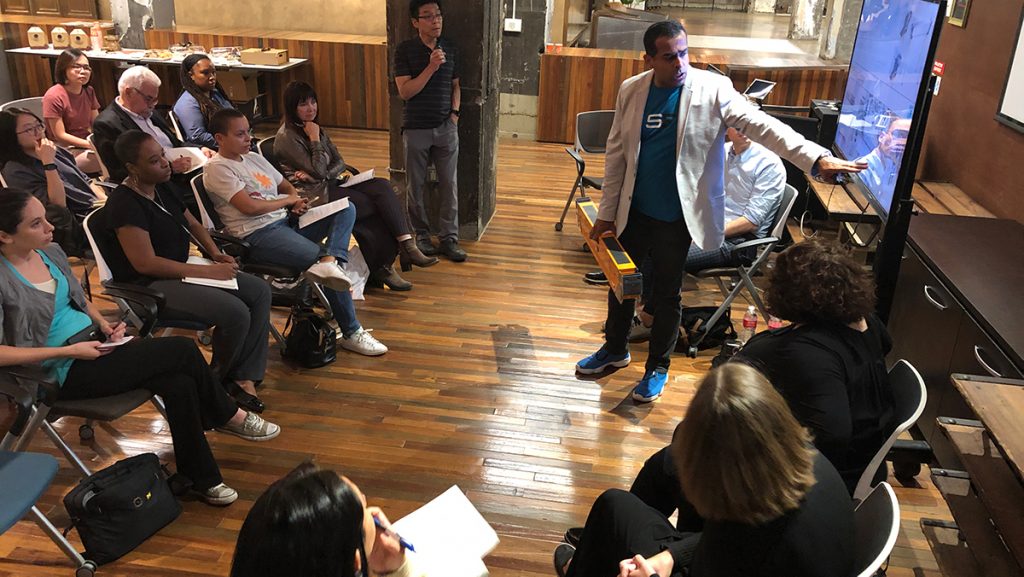
Sundberg-Ferar was chosen to speak on behalf of Detroit’s design community on a panel of representatives from UNESCO Design Cities worldwide! The panel included delegates from the UNESCO Design Cities including Graz, Austria, Kortrijk, Belgium, and Geelong, Australia, and addressed design’s instrumentality in augmenting the manufacturing industries of these cities. Whether bringing thriving communities to the next level, helping to shape emerging manufacturing economies, or revitalizing those that are struggling, design is the agent of manufacturing growth across the globe.
UNESCO Design Cities are part of a network of urban centers committed to creativity as a strategic factor for sustainable urban development. Design Cities cooperate at the local and international levels to promote, connect, and support design, as well as to share knowledge and a common market. Detroit’s designation as a Design City is a testament to our design culture and heritage that goes back many decades and which continues to benefit all of Michigan. To learn more about Detroit’s involvement in UNESCO design cities, click here.
The UNESCO Design Cities panel was one of the crowning events during “Detroit month of Design”, a whole month chalk full of events celebrating the city’s design community and impact every September. Click here to learn more about Detroit Month of Design.
Every delegate on the UNESCO panel represented the local beat of design in his or her corner of the world. Together, they brought us up to speed on exciting changes and rebirths incited by design and manufacturing in their regions. Delegates included regional organizations that foster the growth of design and its partnership with manufacturing in their own communities, as well as others, like Sundberg-Ferar, who have been the influential creators of industry standard setting designs and products that fuel local manufacturing. To learn more about how Sundberg-Ferar has contributed to Detroit and America’s creative culture over our 85-year history, click here.
In the course of conversation, a couple of key questions came up. For example: how do you communicate the value of design in cities where, historically, the primary focus has been on manufacturing? As Stijn Deballie of Design Regio Kortrijk let on, it’s not easy! However, his organization has been able to increase communication of the value of design by highlighting the success stories of products created through partnerships of design and manufacturing in their region. Sundberg-Ferar’s Jeevak added that communication of the value of design has its most authentic expression in the design process itself. The design mindset and design thinking adds multi-dimensionality of thought and exploration to the manufacturing world. It invests in multiple verticals, rather than being focused on one vertical, or one product. Design thinking helps a manufacturer not just solve problems, but solve the right problems beautifully. To learn more about the design mindset, click here.

Chris Silvestroni, Coordinator of the Geelong Future Economy Precinct that has used design thinking to save the city after their main manufacturing companies left, added that many people have a very small view of how design thinking can be applied. However, if you invest in educating entire communities and the industries within them about how design can be used to think at a larger scale, encompassing issues like childcare, manufacturing, city planning and more, these communities will get excited about it.
Another important question was raised asking how these cities even began the process of renewal through design, considering the difficulty of getting communities interested in design to begin with – let alone getting leaders to see its value, and consider design thinking as a strategic function. Here, the panel was almost unanimous in their response. In every case, the process began out of necessity. A city or region was facing obsolescence or financial and economical hardship, and every time, design was the force that lifted that region back up to global economic relevance and competition. Design as a strategic function is key to differentiate your company, community, or government offering. Design thinking offers a guide and roadmap in a constantly changing world with uncertain futures, because it is fundamentally built to handle ambiguity. It is the function that can lead a region on the brink of ruin to a vibrant rebirth.
This was the case in every city represented in the UNESCO cities panel. Certainly, in Detroit, design has been the lifeblood of our city and has seen us through countless economic and social storms. Detroit’s defining characteristics are permeated with design, rebirth and innovation. From Henry Ford’s definitive vision for the automotive industry, to the long history of architectural feats that still shape our city skyline, to the city’s ongoing economic rebirth, to the products designed and made here that have revolutionized the world of everyday objects. Detroit has been driven by design thinkers who have taken uncertain times, ambiguity, and hardship, and used it to fuel the vision of greater future possibilities. Detroit is the self-revitalizing force it is today because of design that makes the impossible possible. This is Detroit, and this is Design.
Want to talk with us more about Sundberg-Ferar’s influence on Detroit’s design culture and heritage? Drop us an email!